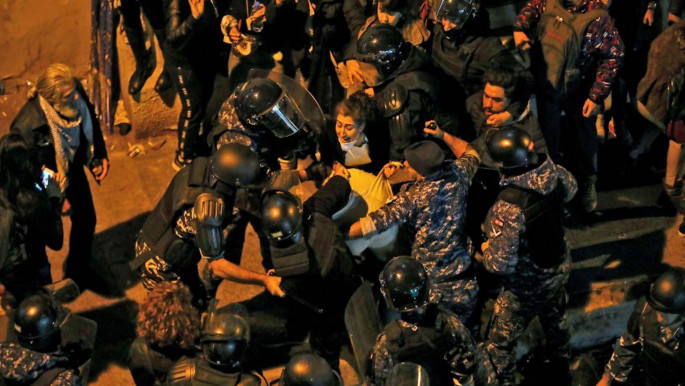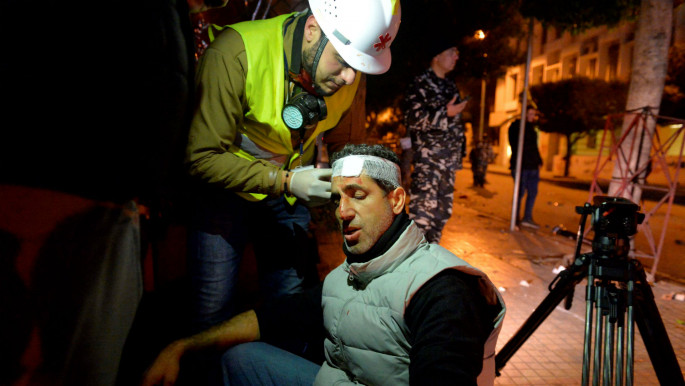Lebanon police forced to apologise after brutalising activists in most violent night since protests began
Protesters clashed with security forces in Beirut Wednesday evening, chanting slogans and demanding the release of some 50 detained demonstrators, before police charged at them and fired teargas to disperse crowds, causing dozens of injuries.
“I apologize to the media, journalists, reports and photographers who were covering what happened yesterday in front of the Helou barracks," said Maj. Gen Imad Othman, head of the ISF, in a televised address on Thursday afternoon.
"The ISF are doing their job in a serious and honest way. They do not want to attack anyone."
Twitter Post
|
However, claims of police violence and harassment flooded social media channels, with many sharing photos and videos of protesters, journalists, and activists being recklessly dragged through the streets of Beirut.
“Around 2,000 to 3,000 people were chanting outside the police station but it was peaceful and then 250 riot police decided to attack people out of nowhere and they started firing tear gas and rubber bullets," Hasan Shaaban, a photojournalist for the Lebanese anglophone outlet The Daily Star, told The New Arab.
He was covering the protest when the security forces began to arrest peaceful demonstrators.
"They made something out of nothing. We weren't doing anything wrong so I wonder what their responses would have been had we actually done something," he added.
Security forces stormed the demonstrators in front of the police station, with protesters began by throwing rocks at security forces.
"People started burning stuff and throwing stones and they started arresting people and started grabbing, dragging and beating them," he said.
"You couldn't see anything. Riot police started throwing at least 200-300 tear gas grenades. Some grenades were even reaching balconies of residential homes. The whole area was suffocating."
|
Hasan said that he saw bruises and wounds on the faces of those who were released from police custody after Wednesday’s clashes.
"Just behind me a 17-year-old boy was dragged by the police by his feet. He was losing his shirt and they were stepping on his face, his head, and his body. I thought to myself 'You are already arresting him, what else do you want?'"
Photos of activist Rafif Souny were shared by social media users and media in Lebanon, describing how the young woman suffered a head injury as a result of the police on Wednesday evening.
Local outlets reported that she was in hospital on Thursday afternoon waiting for doctors to rule whether her alleged memory and eyesight loss might be permanent.
A Reuters photographer, as well as a dozen local and international journalists covering the demonstration, were also caught in the clashes and suffered similar injuries.
Twitter Post
|
"It was so surprising that, as journalists, the police was cracking down on us as badly as protesters and rioters who were breaking windows and attacking banks," said Luna Safwan, a freelance journalist based in Beirut.
"Photojournalists have been doing an amazing job at documenting the protests because they are showing how government forces are treating their people - so police are scared of the cameras," Safwan told The New Arab.
"There are security forces who come to ask you not to film or to take your camera down," added Safwan.
Over a hundred journalists gathered in front of the ministry of the interior in Beirut on Thursday, creating a roadblock to protest their treatment by security forces the night before.
The journalists called for minister of interior, Raya Haffar El-Hassan, to address them on what they saw as an illegal use of force.
Safwan said it was vital for journalists to stage this assembly.
"Today, we sent an important message, because we need the government to know that no one can mess with journalists."
The minister apologised on behalf of the officers blamed for the violence, and added that their behaviour had been due to accrued fatigue.
Many of the journalists were left dissatisfied by what they described as a lacklustre apology.
|
"A decision seemed to have been made by the security forces to just take down and hit everyone you face along the way," Safwan added.
"It was a part of a strategy to intimidate protesters so they won't take to the streets anymore. So far, this has not happened. It seems the violence is pushing people to mobilise more for the total reformation of the government and system."
Lebanon's three months of uprisings have been repeatedly called for an overhaul of the system.
Many are saying that the new government will be announced imminently, and there are doubts this will quell the public.
This unrest follows the assembly angry protests who attacked the facades of bank branches with metal rods, fire extinguishers and rocks.




